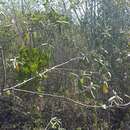en
names in breadcrumbs


Die Cordia rupicola ist eine Strauchart aus der Gattung der Kordien (Cordia) in der Familie der Raublattgewächse (Boraginaceae). Die Art ist auf Puerto Rico sowie Anegada, der nördlichsten der Britischen Jungferninseln, heimisch.
Ein englischer Name für die Art ist „Puerto Rico manjack“.
Cordia rupicola wächst als ein relativ kleiner verholzender Strauch; er erreicht Wuchshöhen von etwa 1,5 bis 5 Metern. Seine Laubblätter sind oval-elliptisch und 2 bis 9 Zentimeter lang. Oberseits sind die Blätter rau; die Blattunterseite ist behaart. Der Blattstiel ist etwa 2 bis 10 Millimeter lang.
Die Blüten sind klein und weiß. Die rote Frucht ist etwa 4 mal 4 Millimeter groß und enthält einen einzelnen Samen.[1]
Cordia rupicola ist eine seltene, vom Aussterben bedrohte Pflanze.[2] Man nahm an, dass sie auf Puerto Rico endemisch ist, bis 1987 Vorkommen auf Anegada beschrieben wurden.
Erstmals wurde die Pflanze 1886 auf Puerto Rico in Los Indios, gelegen zwischen Guayanilla und dem Distrikt Barinas in Yauco, entdeckt. Ein Jahr darauf wurde sie in Guánica gefunden. Auf der Puerto Rico vorgelagerten Insel Vieques wurden einzelne Exemplare gefunden.[3] 1995 wurden 15 Exemplare bei El Peñón in Peñuelas auf Puerto Rico gefunden. Dieser Standort ist ein subtropischer Trockenwald auf Kalkstein; zu den dort wachsenden Baumarten zählen Bourreria succulenta var. succulenta, Bucida buceras und Bursera simaruba.[3] Die durchschnittliche Regenmenge beträgt dort unter 66 Zentimeter.[4]
Zwei bestätigte Vorkommen auf Anegada liegen im Westteil der Insel und bedecken eine Fläche von weniger als 5 km². Cordia rupicola wächst dort auf Kalkstein und auf Sanddünen, scheint jedoch Kalkstein etwas zu bevorzugen.[3][2]
Die Erstbeschreibung von Ignaz Urban wurde 1899 veröffentlicht.[5] Ein Synonym ist Varronia rupicola (Urban) Britt.
Die Cordia rupicola ist eine Strauchart aus der Gattung der Kordien (Cordia) in der Familie der Raublattgewächse (Boraginaceae). Die Art ist auf Puerto Rico sowie Anegada, der nördlichsten der Britischen Jungferninseln, heimisch.
Ein englischer Name für die Art ist „Puerto Rico manjack“.
Varronia rupicola, synonym Cordia rupicola,[2] commonly known as the Puerto Rico manjack, is a critically endangered species of flowering shrub in the borage family, Boraginaceae, that is native to the islands of Puerto Rico and Anegada.[3]
The species was discovered by German botanical collector Paul Sintenis in 1886.
Varronia rupicola is a small woody shrub that measures 1.5–5 m (4.9–16.4 ft) in height. Its leaves are oval-elliptical measuring from 2–9 cm (0.79–3.54 in). The leaf upper surface is rigidly scabrous, puberulous underneath, and the strigose petioles (the stalk of the leaves) are 2–10 mm (0.079–0.394 in) long. It produces small white flowers which yield a one-seeded red fruit measuring 4 mm (0.16 in).[4]
The species was believed to be endemic to Puerto Rico until it was described from the island of Anegada in 1987. The species was discovered in Los Indios, between Guayanilla and barrio Barinas in Yauco in 1886. A year later it was found in Guánica. Two reports of a single specimen exist from the island of Vieques but no population has been confirmed.[5] In 1995 fifteen plants were found east of the historical locations at El Peñón in Peñuelas.
El Peñón is a privately owned subtropical dry forest site located in a limestone substrate. The area has a sparse, low brush (2 to 3 m or 6.6 to 9.8 ft) with a few taller trees reaching 4 to 5 m (13 to 16 ft). These trees include Bourreria succulenta var. succulenta, Bucida buceras, and Bursera simaruba.[5] Average rainfall in the area is less than 66 cm (26 in).[6]
Two Anegada sites, each with a few dozen individuals, have been confirmed.[5] Both sites are located in the western part of the island and cover an area of less than 5 km2 (1,200 acres). In Anegada the species is locally abundant in limestone and sand dunes, showing a slight preference for limestone.[1]
The IUCN assessment considered all Puerto Rican populations extirpated.[1]
Varronia rupicola, synonym Cordia rupicola, commonly known as the Puerto Rico manjack, is a critically endangered species of flowering shrub in the borage family, Boraginaceae, that is native to the islands of Puerto Rico and Anegada.